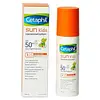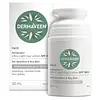What's inside
What's inside
 Key Ingredients
Key Ingredients

 Benefits
Benefits

 Concerns
Concerns

 Ingredients Side-by-side
Ingredients Side-by-side

Methylene Bis-Benzotriazolyl Tetramethylbutylphenol
UV FilterC12-15 Alkyl Benzoate
AntimicrobialDibutyl Adipate
EmollientDicaprylyl Carbonate
EmollientPentylene Glycol
Skin ConditioningDimethicone
EmollientAlcohol Denat.
AntimicrobialCetyl Phosphate
EmulsifyingGlycerin
HumectantCetyl Alcohol
EmollientTriethanolamine
BufferingPanthenol
Skin ConditioningTocopherol
AntioxidantLecithin
EmollientDecyl Glucoside
CleansingCarbomer
Emulsion StabilisingPropylene Glycol
HumectantXanthan Gum
EmulsifyingBHT
AntioxidantAloe Barbadensis Leaf Juice
Skin ConditioningMethylene Bis-Benzotriazolyl Tetramethylbutylphenol, C12-15 Alkyl Benzoate, Dibutyl Adipate, Dicaprylyl Carbonate, Pentylene Glycol, Dimethicone, Alcohol Denat., Cetyl Phosphate, Glycerin, Cetyl Alcohol, Triethanolamine, Panthenol, Tocopherol, Lecithin, Decyl Glucoside, Carbomer, Propylene Glycol, Xanthan Gum, BHT, Aloe Barbadensis Leaf Juice
Homosalate
Skin ConditioningEthylhexyl Salicylate
UV AbsorberButyl Methoxydibenzoylmethane
UV AbsorberBis-Ethylhexyloxyphenol Methoxyphenyl Triazine
Skin ConditioningEthylhexyl Triazone
UV AbsorberPhenylbenzimidazole Sulfonic Acid
UV AbsorberAminomethyl Propanol
BufferingAcrylates/C10-30 Alkyl Acrylate Crosspolymer
Emulsion StabilisingAloe Barbadensis Leaf Juice
Skin ConditioningBenzyl Alcohol
PerfumingButyloctyl Salicylate
Skin ConditioningTocopheryl Acetate
AntioxidantDibutyl Adipate
EmollientDimethicone
EmollientDisodium EDTA
Ethylhexylglycerin
Skin ConditioningGlycerin
HumectantColloidal Oatmeal
AbsorbentPhenoxyethanol
PreservativeWater
Skin ConditioningPvp
Emulsion StabilisingSodium Hyaluronate
HumectantHomosalate, Ethylhexyl Salicylate, Butyl Methoxydibenzoylmethane, Bis-Ethylhexyloxyphenol Methoxyphenyl Triazine, Ethylhexyl Triazone, Phenylbenzimidazole Sulfonic Acid, Aminomethyl Propanol, Acrylates/C10-30 Alkyl Acrylate Crosspolymer, Aloe Barbadensis Leaf Juice, Benzyl Alcohol, Butyloctyl Salicylate, Tocopheryl Acetate, Dibutyl Adipate, Dimethicone, Disodium EDTA, Ethylhexylglycerin, Glycerin, Colloidal Oatmeal, Phenoxyethanol, Water, Pvp, Sodium Hyaluronate
 Reviews
Reviews

Ingredients Explained
These ingredients are found in both products.
Ingredients higher up in an ingredient list are typically present in a larger amount.
Aloe Barbadensis Leaf Juice comes from leaves of the aloe plant. Aloe Barbadensis Leaf Juice is best known for helping to soothe sunburns. It is also anti-inflammatory, moisturizing, antiseptic, and can help heal wounds.
Aloe is packed with good stuff including Vitamins A, C, and E. These vitamins are antioxidants, which help fight free-radicals and the damage they may cause. Free-radicals are molecules that may damage your skin cells, such as pollution.
Aloe Barbadensis Leaf Juice also contains sugars. These sugars come in the form of monosaccharides and polysaccharides, folic acid, and choline. These sugars are able to help bind moisture to skin.
It also contains minerals such as calcium, 12 anthraquinones, fatty acids, amino acids, and Vitamin B12.
Learn more about Aloe Barbadensis Leaf JuiceDibutyl Adipate is an emollient and solvent. It is created from butyl alcohol and adipic acid.
As a solvent, Dibutyl Adipate helps mix and disperse ingredients evenly.
Dibutyl Adipate is soluble in water and organic solvents. It does not absorb UV rays.
Learn more about Dibutyl AdipateDimethicone is a type of synthetic silicone created from natural materials such as quartz.
What it does:
Dimethicone comes in different viscosities:
Depending on the viscosity, dimethicone has different properties.
Ingredients lists don't always show which type is used, so we recommend reaching out to the brand if you have questions about the viscosity.
This ingredient is unlikely to cause irritation because it does not get absorbed into skin. However, people with silicone allergies should be careful about using this ingredient.
Note: Dimethicone may contribute to pilling. This is because it is not oil or water soluble, so pilling may occur when layered with products. When mixed with heavy oils in a formula, the outcome is also quite greasy.
Learn more about DimethiconeGlycerin is already naturally found in your skin. It helps moisturize and protect your skin.
A study from 2016 found glycerin to be more effective as a humectant than AHAs and hyaluronic acid.
As a humectant, it helps the skin stay hydrated by pulling moisture to your skin. The low molecular weight of glycerin allows it to pull moisture into the deeper layers of your skin.
Hydrated skin improves your skin barrier; Your skin barrier helps protect against irritants and bacteria.
Glycerin has also been found to have antimicrobial and antiviral properties. Due to these properties, glycerin is often used in wound and burn treatments.
In cosmetics, glycerin is usually derived from plants such as soybean or palm. However, it can also be sourced from animals, such as tallow or animal fat.
This ingredient is organic, colorless, odorless, and non-toxic.
Glycerin is the name for this ingredient in American English. British English uses Glycerol/Glycerine.
Learn more about Glycerin